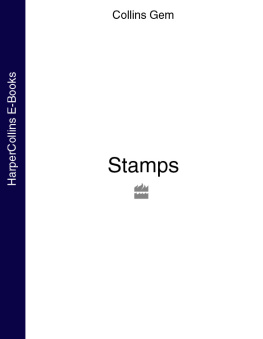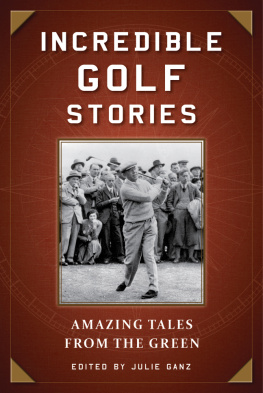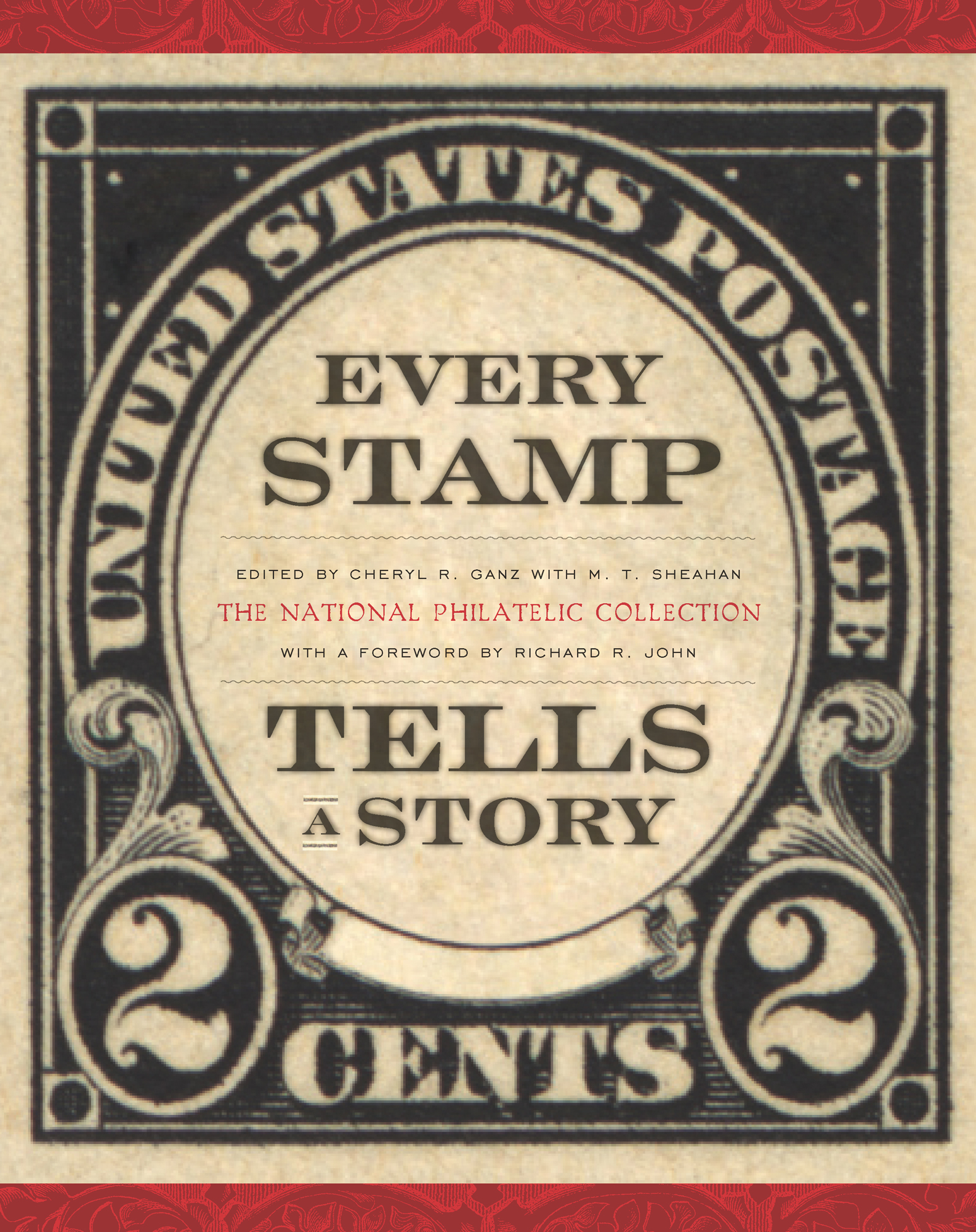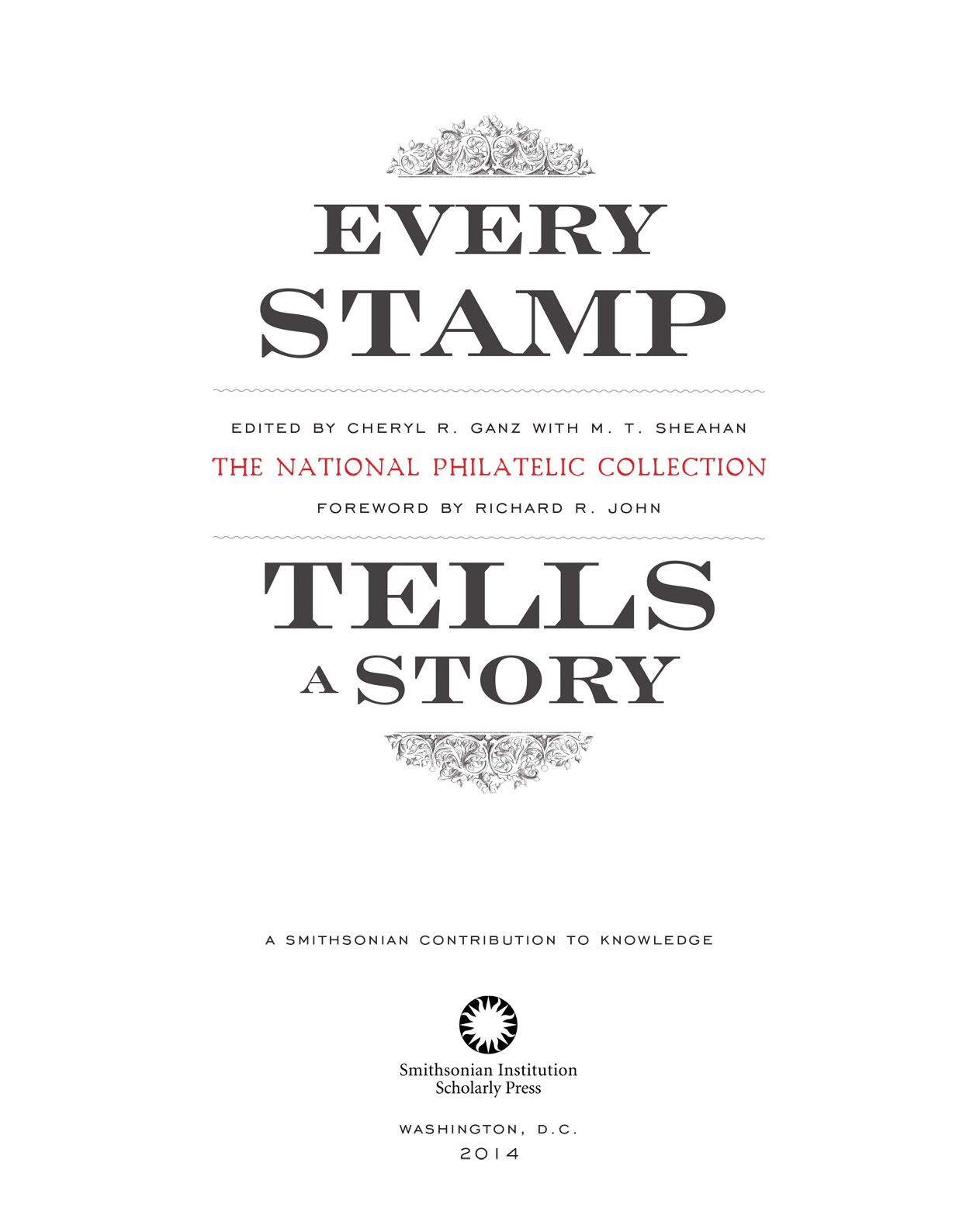
Published by
SMITHSONIAN INSTITUTION SCHOLARLY PRESS
P.O. Box 37012, MRC 957
Washington, D.C. 20013-7012
www.scholarlypress.si.edu
Copyright 2014 by Smithsonian Institution
All rights reserved . No part of this publication may be reproduced, stored in a retrieval system, or transmitted in any form or by any means, electronic, mechanical, photocopying, recording, or otherwise, without the prior permission of the publisher.
All images are courtesy of the Smithsonian National Postal Museum unless otherwise noted. Images are not to scale .
Cover images: Front cover inspired by the 2 Warren G. Harding stamp of 1923; spine includes the 24 Inverted Jenny stamp of 1918; and the back cover features the 29 Smithsonian National Postal Museum imperforate block of four (cropped).
Library of Congress Cataloging-in-Publication Data:
Every stamp tells a story : the National Philatelic Collection / edited by Cheryl R. Ganz, with M.T. Sheahan; with a foreword by Richard R. John.
pages cm. (A Smithsonian contribution to knowledge)
Includes index.
ISBN 978-1-935623-42-7 (hardcover : alk. paper) ISBN 978-1-935623-54-0 (ebook) 1. National Postal Museum (U.S.) 2. Stamp collectionsUnited States. 3. Postage stampsHistory. 4. Postage stampsUnited StatesHistory. 5. Postal serviceUnited StatesHistory. I. Ganz, Cheryl. II. Sheahan, M. T.
HE6204.U5E94 2014
769.56074753dc23
eBook ISBN: 978-1-935623-54-0
Hardcover ISBN: 978-1-935623-42-7
This book may be purchased for education, business, or sales promotional use. For information please write: Special Markets Department, Smithsonian Books, P.O Box 37012, MRC 513, Washington, DC 20013.
www.SmithsonianBooks.com
v3.1
To the Smithsonian Institution curators and stewards who have cared for the National Philatelic Collection and made it accessible to visitors on-site and online and to William H. Gross for making a new home for this national treasure a reality.
PART I
CONNECTING STAMPS TO HISTORY AND CULTURE
The World of Stamps and the Inverted Jenny
Cheryl R. Ganz
Gems of American Philately
Cheryl R. Ganz
History of the National Philatelic Collection
Daniel A. Piazza
PART II
FOCUSING ON UNITED STATES STAMPS
Creation of the National Stamp Collection
Cheryl R. Ganz
The National Stamp Collection
Cheryl R. Ganz, Daniel A. Piazza, and M. T. Sheahan
U.S. Stamp Designs over Time
Cheryl R. Ganz
PART III
EXPANDING BEYOND THE NATIONAL STAMP COLLECTION
The Postmaster Generals Collection
Cheryl R. Ganz and Daniel A. Piazza
The Benjamin K. Miller Collection
Cheryl R. Ganz
U.S. Revenues
Ronald E. Lesher
PART IV
BINDING THE NATION
History of U.S. Postal Operations
Nancy A. Pope
Mail Marks History
Cheryl R. Ganz and Daniel A. Piazza
Military Mail
Lynn Heidelbaugh
Hawaii
Cheryl R. Ganz
Canal Zone and the Missing Bridge Error
Richard Bates
PART V
UNDERSTANDING WORLDWIDE CULTURES THROUGH PHILATELY
The International Collections
Cheryl R. Ganz and Daniel A. Piazza
International Treasures
Daniel A. Piazza
PART VI
CREATING A NEW HOME FOR A NATIONAL TREASURE
The William H. Gross Stamp Gallery
Cheryl R. Ganz
Windows into America
Cheryl R. Ganz
The postage stamp is an icon of modernity. Few artifacts better symbolize the far-flung webs of communications that since the mid-nineteenth century have transformed the world. Far more than the electric telegraphand, until quite recently, to an extent as great as the telephone and the Internetthe mail has fostered sociability by dissolving the age-old barriers that divided families and friends who lived apart. The mail has also been an indispensable instrument of commerce and, in many countries, including the United States, a cornerstone of the infrastructure for the circulation of information on public affairs.
It is thus a cause for celebration that the Smithsonian National Postal Museum has remounted its renowned collection of postage stamps and mail in a grand, historic, and appropriate settingthe former main post office in Washington, D.C. Thanks to the munificence of philanthropist William H. Gross, the public will henceforth have the opportunity to view thousands of postal objects that have until now been hidden away in a vault. The centerpiece of the William H. Gross Stamp Gallery is the National Philatelic Collectionthe greatest collection of U.S. postage stamps and related production specimens in existence, as well as one of the largest and most comprehensive collections of postage stamps and postal markings from the rest of the world.
Every Stamp Tells a Story provides an engaging introduction to the National Philatelic Collection, with a focus on the United States. Its contributors, each an authority on his or her topic, have brought a wealth of knowledge to the challenging task of locating individual postage stamps in their political, cultural, and economic setting, without losing sight of the fascination that these artifacts hold for the many hobbyists who call themselves philatelists. The postage stamps of the United States are truly Windows into America, as curator Cheryl R. Ganz aptly observes in one of her essays for this volume. Their content offers a fast-moving panorama of evolving patriotic ideals and persons (consider the ever-expanding array of people and themes that stamp designers have commemorated over the years) while their form reflects the remarkable technological transformations that have shaped their production, distribution, and usage.
The word philatelist is a nineteenth-century neologism that combines two Greek words philo and ateleia which can be roughly translated as a lover of something that is exempt from taxation. The word reminds us that postage stamps are receipts for a transaction that has yet to occur, making them fitting emblems of a relationship that is founded ultimately on trust. This volume provides philatelists and nonphilatelists alike with fresh insights not only into postage stamps as artifacts but also into the future-oriented cultural moment that gave rise to their invention and that remains a hallmark of the global communications network today.
Richard R. John
Professor
Columbia Journalism School
Images on stamps have influenced the course of history and honored people and places around the world. They have drawn attention to social issues and raised money for important causes. Stamps also provide clues to their production and usage, recording important changes in design, technology, and communications. Every stamp and piece of mail tells a story. In fact, most tell multiple stories.

















